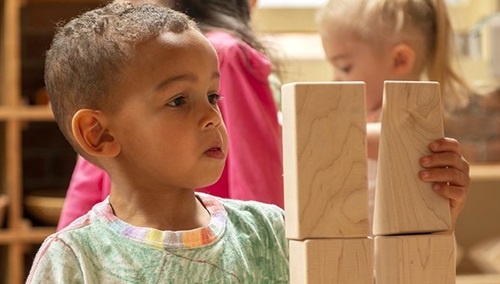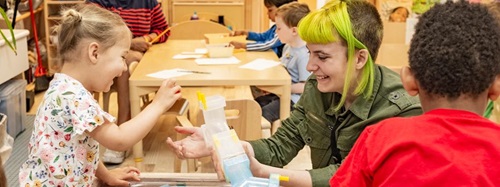Problem Solving Deficit Disorder
| May 2009Creative versus Programmed Play
In November 2005, I participated in an early childhood educators’ conference in South Korea. One of the highlights occurred on a tour of Seoul. While awaiting the opening of a very impressive palace, I saw a group of about twelve 7- or 8-year-old children on a school trip. They had gotten out of their bus and were standing by a large tree with beautifully colored autumn leaves. As I watched them, one child caught a leaf that was floating to the ground. He paused a moment, took off his jacket, and threw it up into the tree. As it fell, it brought down at least a dozen more leaves that he, and a couple of other children tried to catch. Several other children began to throw their jackets into the tree and they all tried to catch the resulting falling leaves. They began calling out. Our translator said the children were counting how many leaves they had caught. After several throwing and catching cycles, the activity evolved into a game in which one child loudly called out what my Korean tour leader told us was “one, two, three.” Then all the children threw up their coats in unison and cheered as they ran around catching the flood of leaves that came cascading down. After about 15 minutes, their teacher called them over to go into the palace that was about to open. The activity was over (Levin, 2007).
When the children lined up to leave, I marveled at:
- how resourceful they were at creating a game using nothing but leaves and coats;
- how the game evolved and changed over time in a natural and spontaneous way;
- how quickly it became a cooperative activity involving the whole group without discussion, stress, or rules;
- how even in a cramped space, no adult limit setting or intervention was necessary; and,
- how long it had been since I had seen a spontaneous, joyful, and playful creation of this sort occur among children in the U.S.
Beginning in infancy, children are bombarded with noise and electronic stimulation, from crib mobiles with flashing lights and music to DVD entertainment systems for the car. Quiet time? Children are programmed never to have it. The gadgets may distract babies from crying, but I wonder do they ever discover their toes?
I imply this on two levels. Literally, the fussy baby who is left alone long enough to find her toes (not more than a few minutes, after all) is making the first step in a long journey. She’s figuring out that she can entertain and distract herself and, she’s also learning something profound: that she has the capacity to solve her own problem.
In terms of human development, that’s an “Aha!” and essential moment. The infant whose parent pushes the button to turn on the mobile may also be comforted and distracted, but he learns nothing about his capacity to solve his own problem or the awareness that he can do so and it is a satisfying experience. This may seem like too much credit to give to 10 toes, but toes are a metaphor for what I see as erosion in opportunities for children to develop critical thinking skills.
The Korean children’s play reminded me of something I had seen a few months before in a classroom closer to home, at a preschool in the U.S. The teacher put play dough on a small table. A child sat down, poked and squeezed it a few times, and left the table. Then another child came over, poked it, and asked, “What does it do?” When I was a group therapist of emotionally disturbed young children and then as a kindergarten teacher many years ago, play dough was a favorite material for both the children and me. It offered endless possibilities that could grow, change, and evolve based on the age, stage, experience, and interests of each child.
When I describe to other teachers the bored or puzzled reactions to play dough I have observed among many children in the U.S., they often nod knowingly and say that they encounter more and more children who have trouble engaging in open-ended play. “Beth Dimock sees this play out in her prekindergarten class at Cambridge Friends School. Children are easily frustrated and bored. ‘They don’t know how to carry through with a project — any project — on their own,’ she says. ‘Why do two playmates at your house end up in front of a video? Because they’re 'bored'. They can’t even solve the problem of what to play’” (Meltz, 2004). As I watched these children fail to interact with play dough, I worried that they were missing out on most of the social, emotional, and cognitive learning opportunities that the South Korean children created so spontaneously with the leaves.
There are not a lot of studies on this yet; but researchers and educators do know that children learn best by initiating, manipulating, and observing cause and effect. And one recent study found that even having a TV on in the background reduced levels of toddler play. (Schmidt, et al, 2008).
Play in Development and Learning
Comparing Korean children’s play with U.S. children’s lack of play concerns me because play is a primary vehicle through which children learn to interact with, control, and master their world. Creative play has enormous power in promoting children’s development and learning. It is in play that children find interesting problems to work on, and develop the skills for solving them.
When children see themselves as problem finders and problem solvers, they develop curiosity about their world and confidence in their ability to figure things out for themselves. Solving one problem leads to a new problem, which they solve by using the skills they developed from solving previous problems. In the course of playing this way, children develop deep interests, improve at, and become “experts” at problem solving. This problem finding and solving process provides a powerful foundation that helps children be motivated, competent learners who are actively engaged with their environment in school and in life.
“’We (Americans) are often told by media and toy marketers that we are giving our kids an edge when we use software to introduce them to art, language, nature, you name it,’ says Pittsburgh psychologist Sharna Olfman. ‘All it does is teach them to be dependent on the screen for instant gratification,’ she says. ‘They are not developing the capacity to use their own creative intelligence.’ Without a doubt problem solving is a cumulative skill that gives a child a sense of inner power” (Meltz, 2004).
Problem Solving Deficit Disorder
What if children do not become problem solvers and experts in tasks of their own choosing over which they have control? They often develop what I have named PSDD — Problem Solving Deficit Disorder (Lohr, 2003).
What Is PSDD? The concept of PSDD grew out of my work on the impact of contemporary society on children. Parents and professionals have observed children who say they are bored a lot. They have trouble becoming deeply engaged in unstructured activities. They lack creativity and imagination and experience difficulty in playing cooperatively with others or resolving conflicts without aggression. They do better when they are told what to do. They prefer structured activities at school, DVDs to watch, or video games to play at home. They ask for new things all the time, but quickly become bored once they have them. When they are able, parents often enroll their children in organized afterschool activities, so the children will not be bored or spend their free time watching TV.
Except for urging parents to limit screen time (the American Academy of Pediatrics recommends no TV for children under 2), few researchers say we have to eliminate all screen time and gadgets. However, I would stress that establishing carefully thought out rules and routines for screen time and gadgets is vital and less is usually better. Also keep in mind that for many children, the more they use them, the more they will need them, which can set up a never-ending cycle of increasing dependence.
PSDD describes the condition in which children are no longer active agents of their involvement with the world. It interferes with their ability to engage in play that promotes optimal development, learning, social skills, and conflict resolution. In the long run, it can lead to remote-controlled people who exhibit conformist behavior, accept orders without questioning, and miss out on the joy the Korean children demonstrated in their play.
What Causes PSDD? There are several factors that contribute to PSDD. These include:
- The replacement of free time and free-play activities with media such as TV, video games, computers and DVDs which involve children in a world of someone else’s choosing rather than their own (Levin, 1998; Steyer, 2002).
- Highly structured toys, including sophisticated electronic toys and toys linked to media, that tell children what and how to play and that help them imitate the scripts they see on the screen (Levin & Carlsson-Paige, 2006).
- The growing emphasis on academic, skill-based curricula in early childhood settings that undermine children’s creative play and problem solving.
- An increasingly commercial culture that teaches young children “I want it” rather than “I can do it.” (Levin, 2004) “I can do it” is an essential part of problem solving, playing and learning. (See: commercialfreechildhood.org)
Finding a Cure!
Understanding PSDD and its causes and impact on children can give us a powerful tool for meeting children’s needs through play. Parents and educators can:
- Limit children’s involvement with electronic media;
- Encourage creative play in which children are the scriptwriters, directors, and actors;
- Help children find problems to solve and strategies for doing so;
- Choose toys and play materials that allow children to be the creators of what happens (see www.truceteachers.org);
- Create connections between parents and early childhood professionals supporting creative play and problem solving; and,
- Become advocates for creative play.
References and Resources:
This article appeared in Paradigm Magazine, Winter 2009. It is an adapted version of an article which appeared in Where Do the Children Play? by E. Goodenough.
Levin, D. (2007). Problem Solving Deficit Disorder: Creative vs Programmed Play in Korea and the U.S. In: Where Do the Children Play? Goodenough, E. (Ed.). Detroit, MI: Michigan Television.
Levin, D. (2004, September/October). From “I Want It!” to “I Can Do It!” Promoting Healthy Development in the Consumer Culture. Child Care Information Exchange, 159, 34-37.
Levin, D. (2003). Teaching Young Children in Violent Times: Building a Peaceable Classroom (2nd Edition). Cambridge, MA: Educators for Social Responsibility and Washington, DC: National Association for the Education of Young Children.
Levin, D. (1998). Remote Control Childhood? Combating the Hazards of Media Culture. Washington, DC: NAEYC.
Levin, D. (1996). Endangered Play, Endangered Development: A Constructivist View of the Role of Play in Development and Learning. Playing for Keeps, A. Phillips (Ed.). St. Paul, MN: Redleaf Press.
Levin, D. & Carlsson-Paige, N. (2006). The War Play Dilemma: What Every Parent and Teacher Needs to Know (2nd Ed.). New York: Teachers College.
Lohr, S. (2003, December 7). If the Shoe Ties, They Don’t Wear It. New York Times.
Meltz, B. (2004, January 22). Child Caring: There Are Benefits to Boredom. Boston Globe. Retrieved November 18, 2008 from http://www.boston.com/yourlife/home/articles/2004/01/22/there_are_benefits_to_boredom/
Schmidt, M.E., Pempek, T.A., Kirkorian, H.L., Lund, A.F., & Anderson, D.R. (2008, July). The effects of background television on the toy play behaviors of very young children. Child Development, 79, 1137- 1151.
Steyer, J. (2002). The Other Parent. New York: Atria Books.






